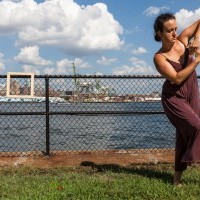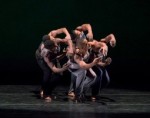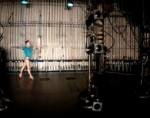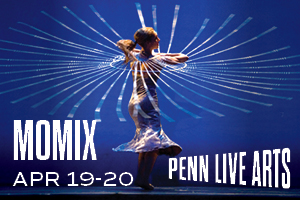
“No Shush Zone”: An Inclusive, Sensory-friendly Nutcracker
by Christina Catanese
Here’s how it usually goes: everyone sits down and gets quiet, and the lights dim about halfway while a voice over the loudspeaker tells us how we should behave and the correct way to experience the performance. It tells us to silence our cell phones, that late seating or re-entry won’t be permitted, not to eat or drink in the theater, and other rules of theater etiquette (though, like norms often do, many go unstated). Then, the lights go down to dark and the audience is bathed in sound as the music swells before the curtain rises on the dancers onstage.
But this performance instead began with a declaration: “Welcome to the relaxed performance of George Balanchine’s The Nutcracker. This performance is fully inclusive and sensory-friendly.” The audience was invited to “bring our full selves with no apologies” to this “no shush zone.” In place of a list of don’ts, the loudspeaker voice noted all the ways that everyone is welcome at this performance and the resources that are available to make sure that everyone has a positive experience. Attendees were welcomed to vocalize during the performance, to enter and exit the theater as needed, and to move freely. “Cool spaces” were designated when a more quiet moment was needed, and noise-cancelling headphones and fidget objects were available in the lobby. The loudspeaker voice quieted, but the lights stayed on as The Nutcracker’s overture swelled.
This is the fourth year that the Pennsylvania Ballet (PAB) has partnered with Art-Reach to offer a relaxed performance of The Nutcracker. Sensory-friendly performances create a welcoming environment for families with children who may have sensory sensitivities. “The Nutcracker is a holiday tradition for so many families and that shouldn’t exclude anyone,” said Pennsylvania Ballet Artistic Director Angel Corella. “We’ve heard over the years from so many families that they hoped to bring their child to enjoy the wonder of The Nutcracker, but were worried about being judged, looked at, or not understood if they were acting a bit differently.”
Art-Reach Executive Director John Orr described how Art-Reach worked with the Pennsylvania Ballet to create an “adaptive environment,” not messing with the performance itself. Corella added, "It’s the full, beautiful production with minor but significant modifications to the experience."
For people with sensory sensitivities, the unpredictability of theater experiences can be a challenge. Thus, preshow materials were developed by Roger Ideishi, Director and Professor of Occupational Therapy at George Washington University, who focuses on creating community access and opportunity for children with diverse sensory and cognitive abilities. The preshow materials give advance notice of what is coming so it won’t be so startling to viewers. The text and images prepare audiences for the experience of going to the theater, as well as sharing details of The Nutcracker’s story and characters. Ideishi and Art-Reach work with PAB to update these materials as needed when the production makes changes: for example, this year there was a new lighting structure to the tree.
Katie Samson, Art-Reach’s Director of Programs, does pre-performance training with ushers to let them know what to expect, and that they can loosen their usual enforcement of the rules. “I think it’s their favorite day of the year,” she said, since they don’t have to be the police, but can just see the joy in the families who can take part in this classic holiday experience.
“We hear time and again that this is an opportunity for an entire family to do something together. Many are making it their annual tradition and several families were coming for their fourth year,” Corella noted. “One big learning we had at Pennsylvania Ballet is the concept of the ‘split family’ in the accessibility world. Since many times there is maybe one child with a sensory issue in a family, parents will then need to split time, with one parent doing an activity with one child and the other doing something completely separate with the other. Our sensory-friendly production of The Nutcracker allows everyone to enjoy time together.”
The Pennsylvania Ballet also donates tickets (distributed by Art-Reach) to people who need the relaxed atmosphere and might not otherwise have access to the performance, and it offers many free workshops with people with disabilities. Ideishi noted, “Big sensory-friendly performances like this get a lot of press, but there are many smaller avenues with very human stories that are engaging people with diverse abilities in the arts.”
At the relaxed production of The Nutcracker, I expected to feel more surprised or distracted by having the “normal” trappings of theater stripped away. Instead, I found myself questioning the norms of theater etiquette themselves. Who made these rules, and whom are they serving? What value do they continue to bring? What is the point of an art culture that is shushy and exclusive?
The relaxed environment didn’t detract from my enjoyment or experience of the performance at all; if anything, it enhanced it. I was heartened to be in a room full of people who felt welcomed and encouraged to be there, and who might not have come otherwise. What did it matter to me that people were moving around me, or that children announced to their caregivers what was happening on stage?
And the production they saw there had all the excitement of the Balanchine classic, executed exceptionally by the cast. Nick Patterson’s energetic solo in “Candy Cane” got some of the biggest applause, and young Aofie Mary DiPalma’s mischievous Fritz got the most laughs in the party scene (though the bits with misbehaving children being carried away by their parents played differently to me in this context). The dancers seemed more connected with the audience, being able to see faces in the half-lit house.
Art-Reach representatives in the lobby sported t-shirts that read, “Art & Culture for Everyone Every Day.” I asked Orr if that meant that the goal was not to have just one sensory-performance out of dozens, but to have all people welcomed at all performances. He told me, “Amtrak got it right—there is one quiet ride car. It’s the exception, not the rule.” I left the bustling lobby wondering, how can we make more space for the full spectrum of ways people experience dance?
The Nutcracker: Sensory-Friendly Performance, Pennsylvania Ballet, Academy of Music, Dec 30.
By Christina Catanese
January 9, 2020






.png)


